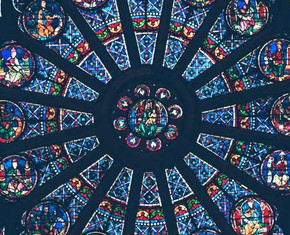The views expressed in our content reflect individual perspectives and do not represent the authoritative views of the Baha'i Faith.
Growing up as a Christian kid, I used to wonder about the return of Jesus – and how I would know when he returned. So I asked my mother, again and again, just to make sure.
Although she didn’t know the specifics — who would? who could? — she said that everyone would know the day when Jesus finally returns. I thought it was a good answer, but then I wondered: what if everyone didn’t know when Jesus returns? What then?
RELATED: How Unpacking Religious Conflict Leads to Spiritual Truth
Consider, in its literal sense, this prophecy of Jesus, from the Gospel of Matthew, chapter 24, verses 29–31:
Immediately after the tribulation of those days shall the sun be darkened, and the moon shall not give her light, and the stars shall fall from heaven, and the powers of the heavens shall be shaken:
And then shall appear the sign of the Son of man in heaven: and then shall all the tribes of the earth mourn, and they shall see the Son of man coming in the clouds of heaven with power and great glory.
And he shall send his angels with a great sound of a trumpet, and they shall gather together his elect from the four winds, from one end of heaven to the other.
If read literally, this passage would appear to say that that the sun, high in the sky, will suddenly turn dark, and the moon as well, so that the whole world will be plunged into near-total darkness. Then Jesus will appear, coming down, on a cloud, from Heaven to Earth. And then a great trumpet sound will be heard aloud around the world, and Christ will physically regather all Christians, past and present, “from one end of heaven to the other.”
Hard to imagine, isn’t it? Truly impossible, without suspending the physical laws of nature. Yet faith in Jesus means that his prophecies must be true. If they are true, they must be destined to come true. So how can this prophecy actually come true? Is there another way — a better way — to understand this important prophecy of Jesus?
If a literal reading of these passages from Matthew sounds too far-fetched to be true, then that’s another reason to think twice about a literal reading. So what’s the alternative? Instead of trying to figure out this prophecy literally, why not spiritually? One simple way to do this uses the following technique: simply add the word “spiritual” before each and every important noun that would otherwise be interpreted as literal or physical, like this:
Immediately after the [spiritual] tribulation of those days shall the [spiritual] sun be darkened, and the [spiritual] moon shall not give her light, and the [spiritual] stars shall fall from heaven, and the powers of the heavens shall be shaken:
And then shall appear the sign of the [spiritual] Son of man in [spiritual] heaven: and then shall all the tribes of the [spiritual] earth mourn, and they shall see the [spiritual] Son of man coming in the [spiritual] clouds of heaven with power and great glory.
And he shall send his [spiritual] angels with a great [spiritual] sound of a [spiritual] trumpet, and they shall gather together his elect from the four winds, from one end of heaven to the other.
Make sense? Let us now see how Baha’u’llah, the prophet and founder of the Baha’i Faith, interprets this passage in his Book of Certitude:
… by “oppression” is meant the want of capacity to acquire spiritual knowledge and apprehend the Word of God. By it is meant that when the Day-star of Truth hath set, and the mirrors that reflect His light have departed, mankind will become afflicted with “oppression” and hardship, knowing not whither to turn for guidance. Thus We instruct thee in the interpretation of the traditions, and reveal unto thee the mysteries of divine wisdom, that haply thou mayest comprehend the meaning thereof, and be of them that have quaffed the cup of divine knowledge and understanding.
In the phrase I’ve italicized above, Baha’u’llah implies that a new messenger of God often provides the keys to understanding the former ones. This implied meaning derives from the expression, the “Word of God.” So who speaks the “Word of God”? God, right? Not quite. Remember that Jesus is described as the “Word” in the preamble to the Gospel of John, Chapter 1, verses 1–5:
In the beginning was the Word, and the Word was with God, and the Word was God.
The same was in the beginning with God.
All things were made by him; and without him was not any thing made that was made.
In him was life; and the life was the light of men.
And the light shineth in darkness; and the darkness comprehended it not.
In other words, the word of God is God speaking through His prophets, who forthtell as well as foretell. Here, “oppression” is not an act of commission, but of omission. Without access to the word of God for one’s day and age, no light shines in the spiritual darkness.
In the following passage from the same book — The Book of Certitude — Baha’u’llah clearly explains the symbols (also with added italics) found in the passage from the Gospel of Matthew, cited above:
And now, with reference to His words: “And then shall all the tribes of the earth mourn, and they shall see the Son of man coming in the clouds of heaven with power and great glory.” These words signify that in those days men will lament the loss of the Sun of the divine beauty, of the Moon of knowledge, and of the Stars of divine wisdom. Thereupon, they will behold the countenance of the promised One, the adored Beauty, descending from heaven and riding upon the clouds. By this is meant that the divine Beauty will be made manifest from the heaven of the will of God, and will appear in the form of the human temple. The term “heaven” denoteth loftiness and exaltation, inasmuch as it is the seat of the revelation of those Manifestations of Holiness, the Day-springs of ancient glory. These ancient Beings, though delivered from the womb of their mother, have in reality descended from the heaven of the will of God. Though they be dwelling on this earth, yet their true habitations are the retreats of glory in the realms above. Whilst walking amongst mortals, they soar in the heaven of the divine presence. Without feet they tread the path of the spirit, and without wings they rise unto the exalted heights of divine unity. With every fleeting breath they cover the immensity of space, and at every moment traverse the kingdoms of the visible and the invisible. Upon their thrones is written: “Nothing whatsoever keepeth Him from being occupied with any other thing;” and on their seats is inscribed: “Verily, His ways differ every day.” They are sent forth through the transcendent power of the Ancient of Days, and are raised up by the exalted will of God, the most mighty King. This is what is meant by the words: “coming in the clouds of heaven.”
In a similar way, Baha’u’llah explained the phrase from Matthew that has baffled theologians for centuries – “the clouds of heaven:”
By these luminous, these conclusive, and lucid statements, the meaning of “heaven” in the aforementioned verse hath thus been made clear and evident. And now regarding His words, that the Son of man shall “come in the clouds of heaven.” By the term “clouds” is meant those things that are contrary to the ways and desires of men. … These “clouds” signify, in one sense, the annulment of laws, the abrogation of former Dispensations, the repeal of rituals and customs current amongst men, the exalting of the illiterate faithful above the learned opposers of the Faith. In another sense, they mean the appearance of that immortal Beauty in the image of mortal man, with such human limitations as eating and drinking, poverty and riches, glory and abasement, sleeping and waking, and such other things as cast doubt in the minds of men, and cause them to turn away. All such veils are symbolically referred to as “clouds.”
RELATED: How Genesis Speaks to Us Right Now
Given these explanations, consider this same passage from the Gospel of Matthew, with Baha’u’llah’s key symbolic interpretations inserted in brackets and italicized:
Immediately after the tribulation [the want of capacity to acquire spiritual knowledge and apprehend the Word of God] of those days shall the sun [of the divine beauty] be darkened, and the moon [of knowledge] shall not give her light, and the stars [of divine wisdom] shall fall from heaven, and the powers of the heavens shall be shaken:
And then shall appear the sign of the Son of man [the divine Beauty = Jesus] in heaven [of the will of God]: and then shall all the tribes of the earth mourn, and they shall see the Son of man coming in the clouds of heaven [veils] with power and great glory.
And he shall send his angels [holy beings … endowed with the attributes of the spiritual] with a great sound of a trumpet [the trumpet-call of Muhammad’s Revelation], and they shall gather together his elect from the four winds, from one end of heaven to the other.
Here, the appearance of each of the best-known messengers of God after Jesus in progressive, historical succession at key turning-points in history — Muhammad, the Bab, and Baha’u’llah — reenacts, and thereby fulfills, Jesus’ paradigmatic and highly symbolic prophecy, because it describes future spiritual events.
Christian systematic theologians call this concept “salvation-history.” In Baha’i terms, this process of the successive appearances of God-sent messengers is called progressive revelation. Abdu’l-Baha, the son and successor of Baha’u’llah, defined this core Baha’i principle in a talk he gave in California in 1912:
Among the bounties of God is revelation. Hence revelation is progressive and continuous. It never ceases. It is necessary that the reality of Divinity with all its perfections and attributes should become resplendent in the human world.
Delving into the prophecies of past religions, and transforming the literal into the spiritual, can help us understand the underlying unity of all Faiths.
















Comments
Sign in or create an account
Continue with Googleor